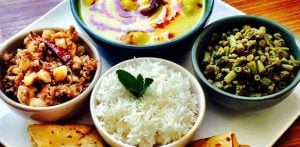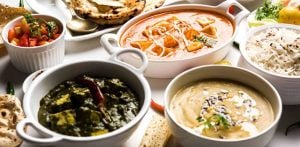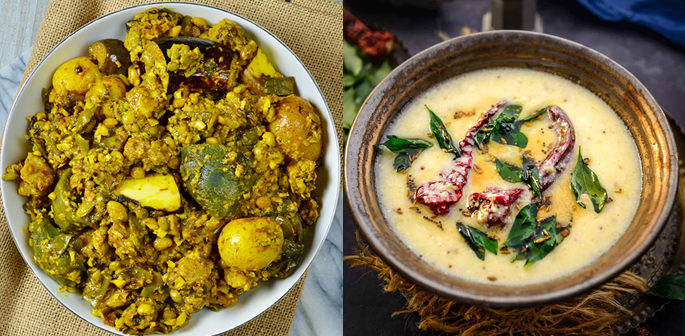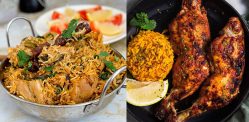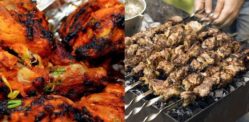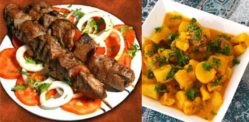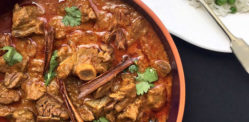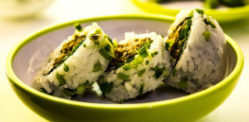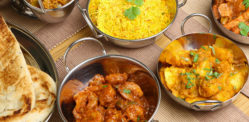Though the dish is complicated, you will relish the time you took out
For centuries, Indian food culture has evolved in bringing forth its rich heritage. Notably, Gujarati curries and dishes have contributed a sense of aesthetic taste and style to India’s culinary heritage.
It is a known fact that no Gujarati meal is complete without a hint of sweetness in it.
Like they have incorporated the relevance of jaggery in their meals, the sweet tongue that gujjus are blessed with is a consequence of the same. Guess, jaggery works its wonders this way!
Traditional Gujarati curries and dishes are a combination of both North and South India. This precisely reflects in a gujju’s adaptable nature.
For a layman, Gujarati food is restricted to dhokla, khakhra and thepla, however, there is more to Gujarati cuisine.
DESIblitz lists 10 Gujarati curries and dishes you must try.
Undhiyu
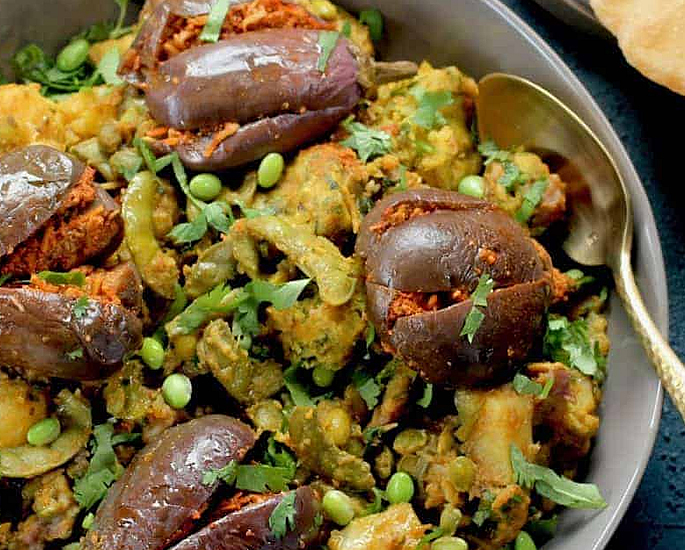
Traditionally cooked on the occasion of Makar Sankranti, undhiyu is one of the most famous Gujarati curries enjoyed across the world.
Larger the quantity, better the taste. This is apparently why gujjus never miss an opportunity to binge on the delicious dish at family get-togethers.
If you are attempting to cook it at home, it is best to work in a team. Though the dish is complicated, you will relish the time you took out to bond with your loved ones.
Derived from a Gujarati word, ‘undhu’ means upside down. Rural Gujaratis cook the dish in earthen pots, sealed and placed upside down in a fire pit dug in the ground.
The curry can be prepared in two styles, Kathiyawadi style, which is native to the Saurashtra region and Surati style, which is a speciality from Surat.
In Surati undhiyu, vegetables are stuffed with peanut and coconut masala. Kathiyawadi undhiyu, on the other hand, is without the stuffing but comparatively spicy.
The rich curry is best served with puri and shrikhand.
Ingredients
For the Muthiya
- 1 cup gram flour
- 1½ cup fenugreek leaves, finely chopped
- ½ tsp red chilli powder
- ¼ tsp turmeric
- ½ tsp cumin powder
- ½ tsp coriander powder
- A pinch of baking soda
- 1½ tsp sugar
- ¼ tsp lemon juice
- Salt, to taste
- 2 tbsp oil, for deep frying
For the Masala Stuffing
- ½ cup fresh, dried and grated coconut
- 1/3 cup roasted peanuts
- 2 tbsp sesame seeds
- ¼ cup coriander leaves, finely chopped
- 2-3 Green chillies
- 1½ inch ginger
- 8-10 Garlic cloves
- ½ tsp turmeric
- ½ tsp red chilli powder
- 3 tsp coriander powder
- 2 tsp cumin powder
- 1 tbsp sugar
- 1 tbsp lemon juice
- Salt, to taste
For the Curry
- 4 Aubergines, stems removed
- 7-8 Potatoes, peeled
- ½ cup hyacinth beans, strings removed
- ½ cup fava beans, strings removed
- ½ cup pigeon peas
- ½ cup sweet potatoes, chopped into 1½ inch pieces
- 1 medium-sized unripened banana cut into 1½ inch pieces
- ½ cup green peas
- A pinch of asafoetida
- ½ tsp carom seeds
- 1 tsp red chilli powder
- ½ tsp cumin seeds
- ½ tsp coriander powder
- 1/3 tsp turmeric
- ¼ tsp garam masala powder
- Salt, to taste
- ½ cup cooking oil
- 1 cup of water
Method
- To make the muthiya, add the gram flour, fenugreek, turmeric, red chilli powder, cumin powder, coriander powder, a pinch of baking soda, sugar, lemon juice and oil to a bowl. Mix the ingredients and keep aside for 10-15 minutes.
- Add 1½ tablespoons of water to make a batter.
- Grease your hands with oil and shape the muthiya into circular balls.
- Heat oil in a frying pan over medium flame. Deep fry the balls over low-flame until the outer layer turns crispy and golden brown.
- Drain the muthiyas on kitchen paper and set aside.
- To make the masala stuffing, grind green chillies, ginger and garlic into a paste. Grind the peanuts.
- Place the coconut, ground peanuts, sesame seeds, coriander leaves, chilli ginger garlic paste, turmeric, red chilli powder, cumin powder, sugar, lemon juice and salt into a bowl. Mix well then set aside.
- Start making the curry by making criss-cross slits in the aubergines and potatoes and stuffing the masala into them.
- Heat the oil in a pressure cooker. After the oil warms up, add carom seeds and cumin seeds. Stir and fry until they change their colour. Add asafoetida.
- Add the hyacinth beans, fava beans, pigeon peas and green peas. Mix well and cook for 3 minutes.
- Now, put red chilli powder, turmeric, coriander powder, garam masala and half of the remaining masala stuffing. After mixing, let it cook for 3 minutes.
- Layer with sweet potatoes and banana. Spread the remaining masala stuffing over. Layer with stuffed aubergine and potatoes. Season with salt and pour in water until covered.
- Close the lid and cook on a medium flame for 3 whistles.
- Gently mix everything with the help of a spatula. Take care not to break the stuffed vegetables.
- Serve with the muthiyas, puri and shrikhand.
This recipe was inspired by Food Viva and Veg Recipes of India.
Stuffed Aubergine & Potato Curry
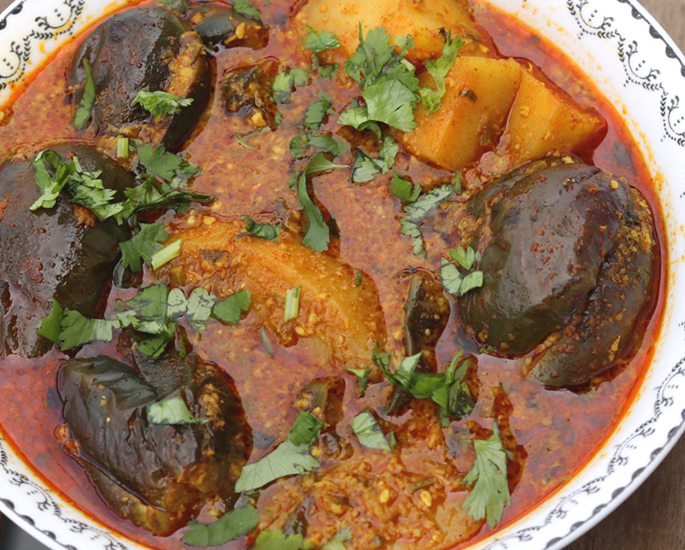
This mouth-watering curry is a combination of stuffed aubergine and potatoes.
Of the well-known Gujarati curries, this one is a staple food in every Gujarati household.
The flavourful curry is often served at Gujarati weddings and gatherings.
A must-have dish in every Gujarati thali, it is one of the most loved traditional Gujarati dishes.
Ingredients
For the Masala Stuffing
- 1 tbsp peanuts, crushed
- 2 tbsp gram flour
- ½ tsp sesame seeds
- 1 tbsp fresh grated coconut
- ½ tsp turmeric
- 1 tsp red chilli powder
- 2 tsp coriander-cumin powder
- ¼ tsp asafoetida
- 2 tbsp coriander leaves, finely chopped
- 1 tsp sugar
- 2 tsp lemon juice
- 2 tbsp oil
- Salt, to taste
For the Aubergines & Potatoes
- 10 Baby aubergines
- 6-7 Baby potatoes
- 1 tsp coriander leaves, finely chopped (for garnishing)
- ¼ tsp asafoetida
- ¼ tsp turmeric
- 1 tsp red chilli powder
- 1 tbsp oil
- ½ cup of water
- 1 tsp mustard seeds
- 1 tsp cumin seeds
- Salt, to taste
Method
- Mix the masala stuffing ingredients in a bowl. Add oil, mix well then set aside.
- Slit the aubergines vertically about three-quarters of the way. Peel the potatoes then do the same.
- Fill the aubergines and baby potatoes with the masala stuffing. Keep the remaining masala stuffing aside.
- In a pressure cooker, heat some oil. Add mustard seeds and let them splutter. Add cumin seeds, asafoetida, turmeric, red chilli powder. Lay the stuffed vegetables into the cooker.
- Add the remaining masala stuffing to the vegetables and gently mix.
- Pour in the water until it is covered and bring to the boil. Pressure cook for 4 whistles. Once the pressure is released, open the lid of the cooker and transfer the vegetables to a serving dish.
- Garnish with coriander and serve with roti.
This recipe was adapted from Pep Kitchen and Gujarati Recipes.
Bardoli ki Khichdi
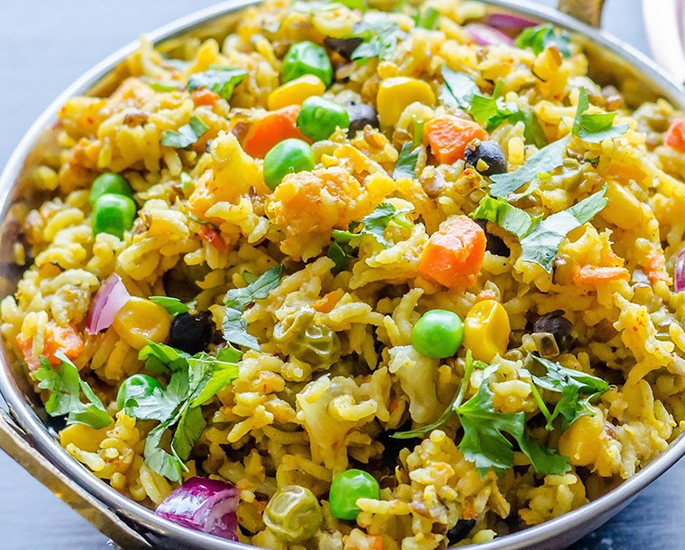
This authentic khichdi recipe hails from the Bardoli region in Gujarat. Unlike other traditional Gujarati dishes, bardoli ki khichdi is tangy and spicy.
It is more like pulao, but tender. Those eating healthy can opt for this meal as it is light and high in protein.
This tastes great with raita and poppadoms.
Ingredients
- 2 cups rice, washed and soaked for 30 mins
- 1½ cups split pigeon peas, washed and soaked for 30 mins
- 2 Potatoes, cubed
- ½ cup green peas
- ½ cup raw mango, grated
- 1 Onion, finely chopped
- 2 inches ginger, finely chopped
- 2 Green chillies, finely chopped
- 1 tsp turmeric
- 1 tsp red chilli powder
- 1 tsp cumin seeds
- ¼ tsp asafoetida
- 1 ½ tbsp ghee
- 1 tbsp coriander leaves (for garnishing)
- Salt, to taste
Method
- Heat the ghee in a pressure cooker. Add the cumin seeds and let it splutter. Sprinkle in the asafoetida.
- Saute the onions until they turn light brown. Add chopped ginger and green chillies. Leave it for a minute. Stir in the mango.
- Add the diced potatoes, green peas, turmeric, red chilli powder. Allow it to cook until the ghee separates from the masala. Mix well.
- Drain the water from the rice and split pigeon peas. Add them to the pressure cooker and stir with the vegetables.
- Add 4 cups of water, sprinkle salt and pressure cook for 4 whistles.
- Transfer to a serving dish. Garnish with half a tablespoon of ghee and chopped coriander leaves. Serve with raita.
This dish was inspired by Archana’s Kitchen.
Gujarati Kadhi
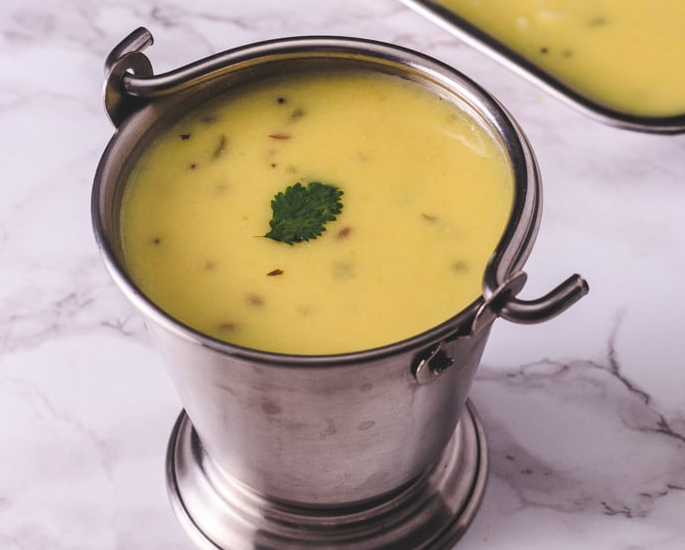
Kadhi is one of the most loved delicacies in North India. It can be teamed up with parathas, rotis, khichdi and rice.
Gujarati kadhi attains its smooth texture due to buttermilk. There are many variations of this Kadhi. It is prepared by adding certain vegetables, koftas or pakoras to it.
Gujarati curries and dishes are incomplete without the element of sweetness in them.
Relating to different versions of kadhi cooked in diverse parts of India, Gujarati kadhi stands out due to its sweet characteristic.
Ingredients
- 2 cups fresh curd
- 5 tbsp gram flour
- 2 tsp ghee
- ½ tsp cumin seeds
- ½ tsp mustard seeds
- 2 pinches of asafoetida
- 5 Curry leaves
- 1 tsp ginger-green chilli paste
- 2 tbsp sugar
- 3 cups of water
- 2 tbsp coriander leaves, finely chopped (for garnishing)
- Salt, to taste
Method
- Blend fresh curd and gram flour in a bowl and ensure that there are no lumps. Pour in the water, stir and keep it aside.
- In a saucepan, heat the ghee then add mustard and cumin seeds.
- Once the seeds start crackling, add asafoetida, ginger-green chilli paste and curry leaves. Let it cook for a minute.
- Slowly pour in the curd and gram flour mixture. Sprinkle salt and sugar. Keep stirring continuously until it starts to boil.
- Reduce the heat and let it simmer for around 10 minutes.
- Add chopped coriander and serve hot.
This recipe was inspired by Tarla Dalal.
Dal Dhokli
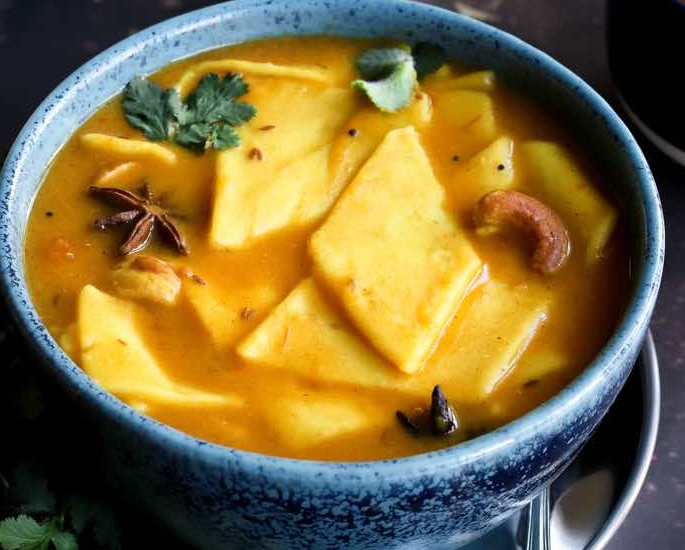
Dal dhokli is a simple and traditional dish within Gujarati cuisine and it does not require any accompaniments.
This comforting dish is a combination of lentil soup and wheat dumplings.
Among Gujarati curries, lentil soups are a healthy source of vitamins and proteins.
The versions of dal dhokli alter as you stroll around different states of the country. The Gujarati version is undoubtedly authentic and original.
Ingredients
For the Dal
- 1 cup split pigeon peas
- ½ tsp turmeric
- 1 tsp red chilli powder
- 1 Tomato, finely chopped
- 5 cups of water
- 1 tsp jaggery, grated
- 3 tbsp lemon juice
- 1 cup fresh coriander leaves (for garnishing)
- ½ cup roasted peanuts
- Salt, to taste
For the Dhokli
- 1 cup wheat flour
- 2 tbsp gram flour
- 1 tsp salt
- 2 tsp vegetable oil
- 1 tsp carom seeds
- ½ tsp turmeric
For Tempering
- 2 tbsp ghee
- ¼ tsp asafoetida
- 1 tsp cumin seeds
- 1 tsp mustard seeds
- 10-12 Curry leaves
- 3-4 Green chillies, cut into half
Method
- Make the dal by washing it and placing it into a pressure cooker. Add 4 cups of water, turmeric powder, red chilli powder, chopped tomatoes and salt.
- Let it cook for 3 whistles until softened. Add 2 cups of water, jaggery and lemon juice. Mix well.
- For the dhokli, add whole wheat flour, gram flour, vegetable oil, carom seeds, turmeric powder and salt to a bowl.
- Gradually add water until it forms a small dough. Make into small balls then roll into thin circles. Cut into pieces.
- Add the pieces to the dal one by one. Cook for 10 minutes until the pieces have fully cooked alongside the dal.
- For tempering, add ghee to a pan. Once heated, add mustard seeds, cumin seeds, asafoetida, curry leaves and green chillies. Let them fry for a few seconds.
- Pour the tempering into the dal, mix well and garnish with coriander.
This recipe was adapted from Whisk Affair.
Handvo
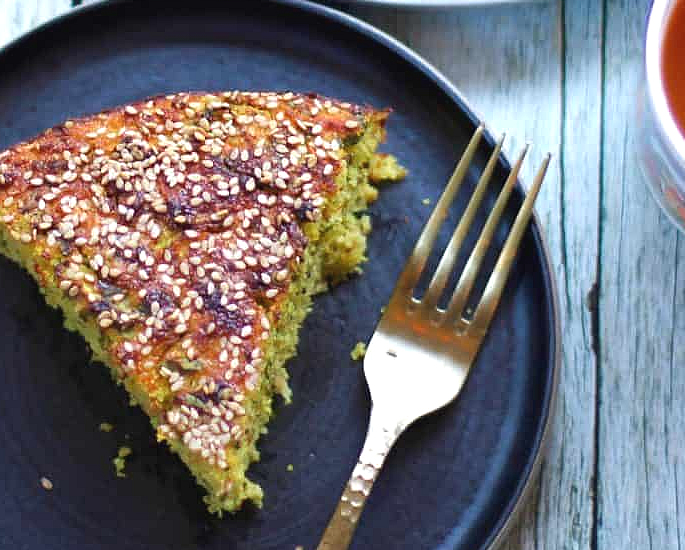
When we hear the word ‘cake‘, the first thing that crosses our mind is ‘a sweet dish’. Gujaratis are always up with discovering something out of the box.
The patented sweetness that Gujarati curries and dishes are known for, is surprisingly absent in handvo.
A savoury cake as it is acknowledged, handvo is a nutritious dish that tantalises the tastebuds.
With a combination of pulses and vegetables, this is a healthy cake that one can binge on without keeping a count on calories.
Ingredients
For the Handvo batter
- 1 cup of rice
- ½ cup split Bengal gram
- ¼ cup split pigeon peas
- 2 tbsp split black lentils
- ½ cup yoghurt
- 1 cup bottle gourd, grated
- ½ cup green peas
- 1 Carrot, grated
- ½ tsp ginger-green chilli paste
- ½ tsp sugar
- ¼ red chilli powder
- ¼ tsp turmeric
- 1 tsp oil
- ½ tsp baking soda
- 1 tsp lemon juice
- Salt, to taste
For the Tempering
- 3 tsp oil
- 1½ tsp mustard seeds
- 1½ tsp cumin seeds
- 3 tsp sesame seeds
- 10-12 Curry leaves
- A pinch of asafoetida
Method
- Wash the rice and lentils and leave them to soak for four hours.
- Once done, transfer to a blender. Blend until it reaches a coarse texture. If the batter is too thin, add a couple of tablespoons of semolina.
- Now, add grated bottle gourd, carrot and green peas. You can add more vegetables if you like. Add ginger-green chilli paste, sugar, red chilli powder, turmeric, oil and salt to the batter.
- Add baking soda and give it a mix. If you do not wish to add soda, ferment the batter overnight or for at least 8-10 hours.
- Now, add lemon juice. The batter is ready for tempering.
- Add 1 tablespoon of oil to a nonstick pan. When the oil heats up, add mustard seeds, cumin seeds, sesame seeds, asafoetida and curry leaves.
- As the seeds start crackling, evenly spread half a cup of handvo batter over the pan. The handvo must be thick so pour the batter accordingly. Now cover the pan with a lid.
- The cooking time depends upon the thickness of handvo. Normally, a 1-inch thick handvo will take about 4-5 minutes to cook on one side.
- Once the bottom layer turns golden brown, flip it on the other side. Cook for about 3-4 minutes.
- Cut into triangular or square-shaped pieces.
- Serve with ketchup or green chutney.
This recipe was inspired by Food Viva.
Sev & Tomato Curry

Sev and tomato curry is a go-to recipe for every Gujarati family. It is easy to cook and takes no time at all.
Even among non-Gujarati people, it is undeniably one of the most famous curries.
In olden times, people stayed in huge joint families. To feed everyone, the vegetables already cooked used to fall short in quantity.
To combat this crisis, the women of the family discovered this yummy delicacy.
This five-minute recipe finds its place not just in Gujarati thali, but it also has a different version from Rajasthan. Nonetheless, it is relished in most parts of India.
Ingredients
- 1½ cup sev
- 2¼ cup tomatoes, chopped
- 2 tbsp oil
- ½ tsp cumin seeds
- ½ tsp asafoetida
- ½ tsp ginger, chopped
- ½ tsp turmeric
- 1 ½ tsp coriander-cumin powder
- 1 tsp red chilli powder
- 1 tsp sugar
- Salt, to taste
Method
- Heat oil in a non-stick pan then add cumin seeds, asafoetida and chopped ginger.
- Once the seeds sizzle, add the chopped tomatoes, turmeric powder, coriander-cumin powder, red chilli powder, sugar and salt.
- Stir occasionally until the tomatoes soften then add 1 cup of water. Continue stirring for 2 minutes on a medium flame.
- When ready to serve, add the sev.
This recipe was inspired by Tarla Dalal.
Patra
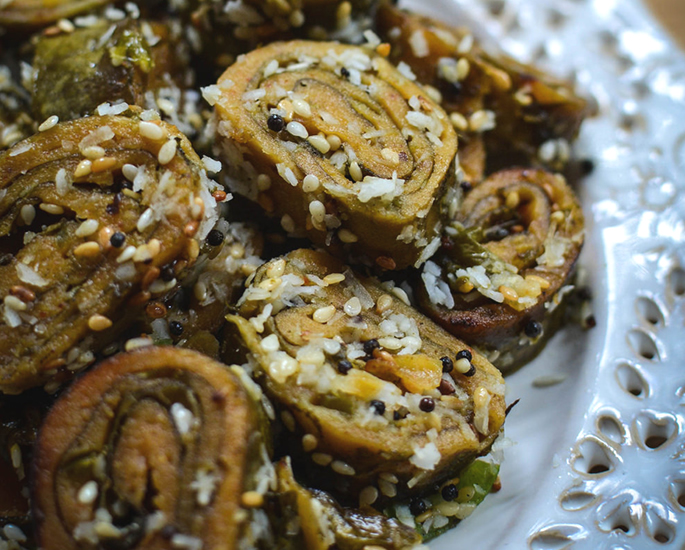
When Gujarati people have guests coming over, it is likely that patra will be one of the side dishes.
Patra is a lip-smacking and healthy appetiser. It is a colocasia leaf recipe which is steamed first and later enhanced with yummy tempering.
As the colocasia leaves are seasonal, one can opt for any leafy vegetable like spinach. Big leaves are preferred so that it becomes easy to roll.
Known as patra in Gujarati, it is also famous as ‘alu vadi’ in Maharashtra.
Ingredients
- 5 Colocasia leaves
For the Paste
- 2½ cups gram flour
- 1 tsp ginger, finely chopped
- 1 tbsp curd/yoghurt
- ¼ tsp turmeric
- 1 tbsp jaggery
- ½ cup tamarind water
- 1 tsp coriander powder
- ¼ tsp asafoetida
- ½ tsp red chilli powder
- 1 tbsp oil
- Salt, to taste
For the Tempering
- ½ tsp mustard seeds
- 1 tsp cumin seeds
- 2 tsp sesame seeds
- ¼ tsp asafoetida
- 2 Curry leaves
- 1 tbsp oil
- 2 tbsp fresh coconut, grated
Method
- Add the paste ingredients to a bowl and add enough water so that it has a thick consistency.
- After drying out the colocasia leaves, place them on a flat surface with its veins facing upwards.
- Remove the thick stock of veins with a knife. Once all the leaves are deveined, clean and pat them dry.
- Place the leaf on a flat surface with its tip facing towards you. Remember that the light green portion must be facing upwards. Smear the paste over it.
- Take another leaf. Place it on the first leaf with its tip facing the opposite direction to that of the first one. Apply the paste. Continue this process till you get 4 layers with 4 leaves.
- Gently fold the edges from both sides, about 1-2 inches inwards.
- Starting from your end, roll up tightly while applying the paste to each fold. The rolled leaves will look like logs. Repeat the process with other leaves.
- Before steaming the patras, preheat the vessel with three cups of water.
- Grease the steamer plates with oil. Place the patra rolls onto the plates. Cover the steamer. Let it steam for 10-12 minutes on high flame.
- Once done, allow them to cool. Ensure that the rolls are properly steamed before we go for tempering. Cut the logs into one-inch pinwheels.
- In a pan, heat oil then add mustard seeds, cumin seeds and sesame seeds.
- Once sizzling, add asafoetida and curry leaves. After 30 seconds, add the patras and cook them until they turn golden brown.
This recipe was adapted from Archana’s Kitchen.
Ghari
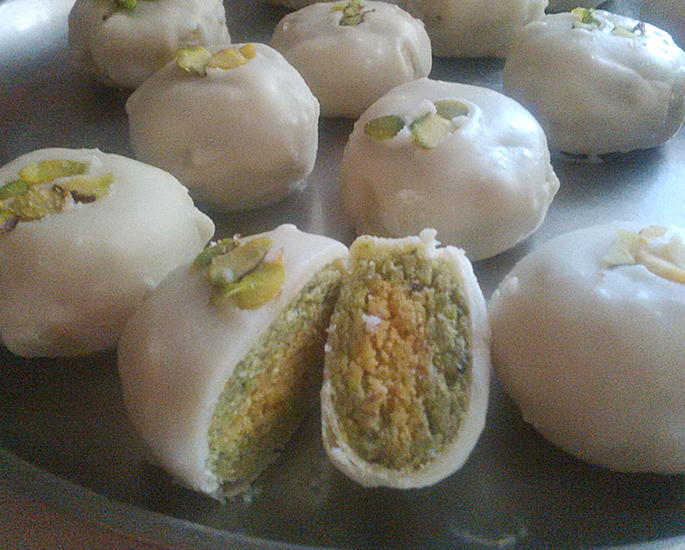
Ghari is a sweet dish filled with ghee and various dry fruits. As a result, it is a filling and rich dessert.
Originally, ghari was prepared in 1857 by the cooks of a freedom fighter named Tatya Tope. This provided his soldiers with excess power and strength.
Even today, the locals of Surat have carried forward the legacy by enjoying this sweet treat.
Approximately 100-150 tonnes of ghari is consumed every year. Relished all over the world, it is one of the Gujarati dishes which is exported in bulk quantities.
Ingredients
For Filling
- 1½ cups ricotta cheese
- ½ cup freshly prepared cottage cheese
- ½ tin condensed milk
- ½ cup of sugar
- 2 tbsp clarified butter (ghee)
- ½ cup semolina
- ¾ cup almonds and pistachios, ground
- 10-15 Cardamom pods, grounded
- 8-10 Saffron strands, soaked in 1 tsp milk
For the Puri
- 1 cup all-purpose flour
- 1 tbsp ghee
- Milk for binding
- 1 cup ghee, for frying ghari
For Garnishing
- 1 cup ghee
- 1/3 cup powdered sugar
- Sliced almonds and pistachios
Method
- To make the filling, heat some ghee in a wok. Once heated, add ricotta cheese and cottage cheese.
- Keep stirring continuously until the ghee and cheese has fully mixed and all the water has absorbed.
- In a separate pan, roast the semolina for about 3-4 minutes on medium flame. Add the roasted semolina to the cheese mixture.
- Add the condensed milk and sugar while continuously stirring.
- As the water evaporates, add almonds, pistachios, cardamom and saffron.
- Mix then remove from the heat and let it cool down. Once it has cooled, make small balls.
- Meanwhile, take the puri ingredients and mix together. Knead into a soft dough. Gradually add milk to bind together.
- Divide the dough into small balls. Use a rolling pin to roll them out.
- Place the small balls made from the filling into the puris. Keeping the ball in the centre of the puri, gather the sides of the puri to cover the filling.
- Seal the filling completely and remove any excess dough. Repeat this process for other balls.
- In a frying pan, heat the ghee on a low flame. Fry the filling balls in the ghee till it becomes goldish brown. Keep an eye as the balls might start sticking on the pan. Once done, set aside to cool for about 3-4 hours.
- Whip the ghee and powdered sugar together until it becomes foamy and light. Dip the fried gharis into the mixture.
- Allow the mixture to set then garnish with almonds and pistachios.
This dish was adapted from inSurat.
Khichu
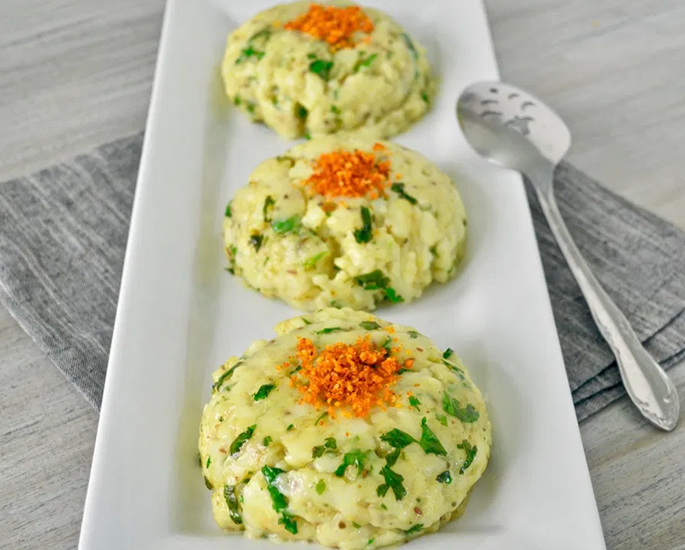
Khichu, or khichiyu is a Gujarati term which derives from the elasticity of its dough.
Appreciated by all age groups, it can be enjoyed at any time of the day.
Popular among Gujarati people, this simple yet comforting food is sure to fill your tummies with delight.
Ingredients
- 2½ cups water
- 1 green chilli, finely chopped
- 1 tsp cumin seeds
- ¼ tsp carom seeds
- ¼ tsp baking soda
- 1 tsp salt
- 1 cup of rice flour
- Peanut oil, for serving
- Pickle masala, for serving
Method
- Pour water into a wok then add cumin seeds, carom seeds, baking soda, green chilli and salt.
- Bring to a boil then add rice flour and stir to ensure no lumps. Continue stirring until the rice flour absorbs the water.
- Cover the kadai with a lid and allow the rice flour to cook. Once, the rice flour has cooked, the mixture will turn soft and fluffy.
- Garnish with peanut oil and pickle masala.
This dish was inspired by Hebbar’s Kitchen.
With these recipes, you can create these dishes yourself instead of having to visit your Gujarati friend.
These vegetarian delights are authentic Gujarati curries and dishes which are bound to please any foodie’s tastebuds.
























